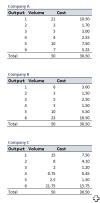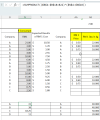Anbuselvam K
Member
Dear Excel Genius,
As per the below snapshot the formula is working and I calculated the cost of RM1 by using the formula
=LET(q,M4:M8,p,Y4:Y8,s,Z4:Z8,sa,SCAN(0,s,LAMBDA(a,v,SUM(a,v)))-s,qa,SUM(q)-sa,
by,BYROW(SCAN(0,q,LAMBDA(a,v,a+v)),LAMBDA(v,LET(qa,v-sa,SUM(IF(qa>0,IF(qa>s,s,qa))*p)))),by-IFERROR(SMALL(by,SEQUENCE(ROWS(q),,0)),))
Above formula provided by the below-linked post Thanks to @Excel Wizard
Attached the file sheet name costing.

Now, the new sheet named Costing New has 3 companies RM consumption N:N Price AA:AA and the Qty AB:AB.
Company name mentioned in the column B and Z. I transfer the same formula but there is a error of Spill.
After correcting the error I need the costing of each row with the specified company name.
Company A consumption N:W must use company A price and Qty in the column AA and AB respectively.
Likewise, I need Y column results as per the company A, B, C
RM1 purchase price and Qty of A company must use the same company consumption only.
For example I added 5 rows of A then B then C in line. But actually all consumption, Price and Qty will get random Entry too.
likely AAAABBBCCCAACCBBAACBA....etc. So in the formula need to take care of this too.
Here I request you to correct the error in the formula as well as RM1 Cost must be extracted by company wise too.
Thanks in advance.

As per the below snapshot the formula is working and I calculated the cost of RM1 by using the formula
=LET(q,M4:M8,p,Y4:Y8,s,Z4:Z8,sa,SCAN(0,s,LAMBDA(a,v,SUM(a,v)))-s,qa,SUM(q)-sa,
by,BYROW(SCAN(0,q,LAMBDA(a,v,a+v)),LAMBDA(v,LET(qa,v-sa,SUM(IF(qa>0,IF(qa>s,s,qa))*p)))),by-IFERROR(SMALL(by,SEQUENCE(ROWS(q),,0)),))
Above formula provided by the below-linked post Thanks to @Excel Wizard
Expect Excel formula to find the product price by FIFO Method
Dear Excel Genius I have produced some products in my company which is having or used different raw materials purchased with different prices. I want to calculate the products price per kg by using (Raw Materials) FIFO Method. Below is the example data I have calculated Products 1 to 5's RM 1...
chandoo.org
Attached the file sheet name costing.

Now, the new sheet named Costing New has 3 companies RM consumption N:N Price AA:AA and the Qty AB:AB.
Company name mentioned in the column B and Z. I transfer the same formula but there is a error of Spill.
After correcting the error I need the costing of each row with the specified company name.
Company A consumption N:W must use company A price and Qty in the column AA and AB respectively.
Likewise, I need Y column results as per the company A, B, C
RM1 purchase price and Qty of A company must use the same company consumption only.
For example I added 5 rows of A then B then C in line. But actually all consumption, Price and Qty will get random Entry too.
likely AAAABBBCCCAACCBBAACBA....etc. So in the formula need to take care of this too.
Here I request you to correct the error in the formula as well as RM1 Cost must be extracted by company wise too.
Thanks in advance.







